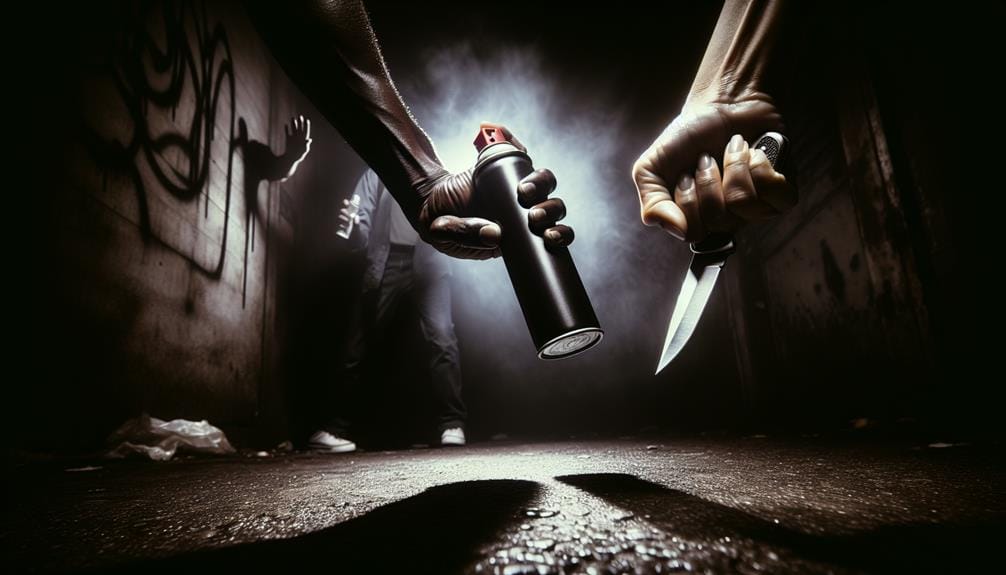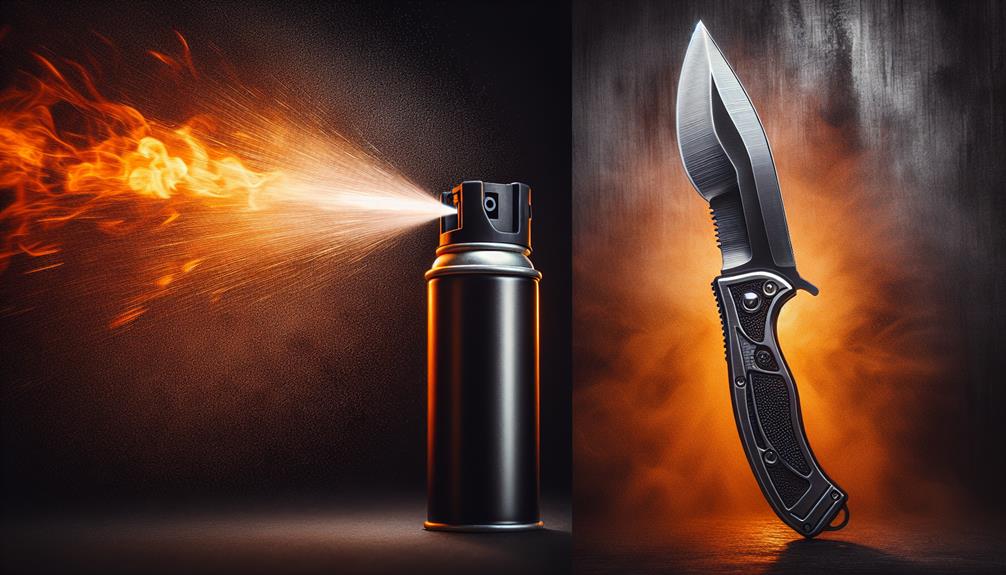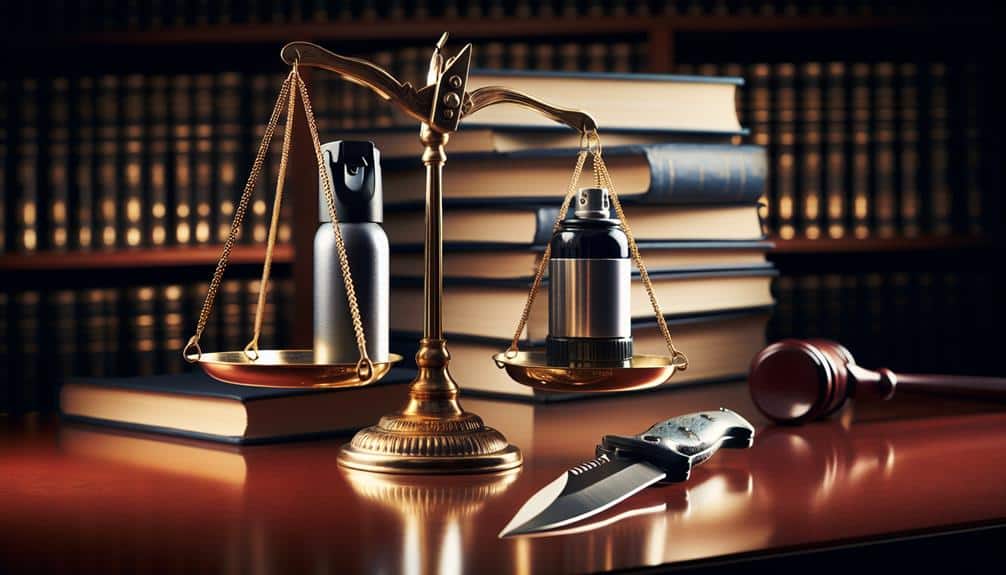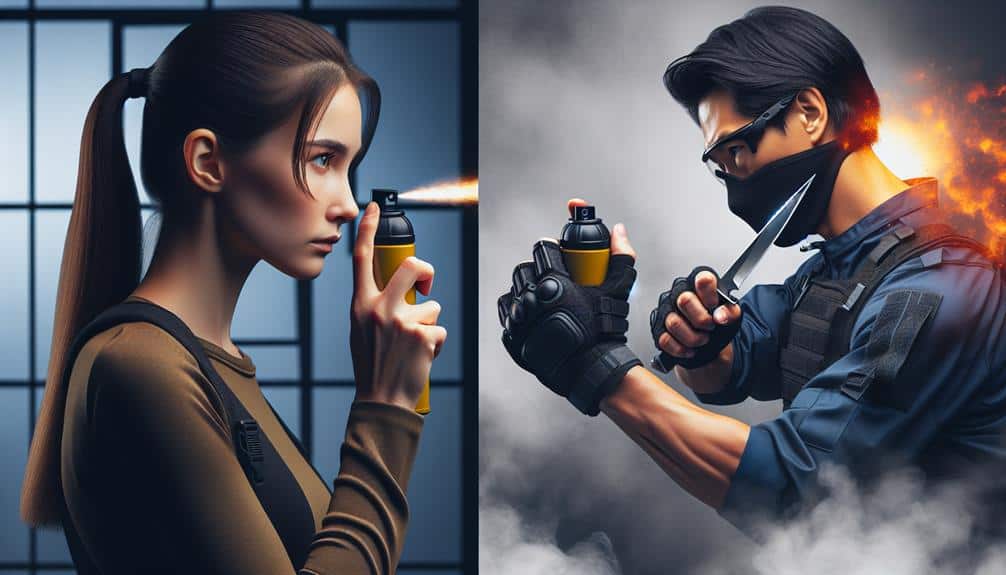Safety Showdown: Pepper Spray or Knife – Which Should You Choose?

Choosing between pepper spray and a knife for self-defense is like deciding between a fire hose and a flamethrower — both pack a punch, but in different ways. Pepper spray is your trusty sidekick, spraying doom from a distance and giving you enough time to escape without much fuss. Knives, though effective, require ninja-level training and can be a bit, well, messy. Plus, going Rambo in a panic situation can be tricky. Don’t forget about the legal stuff; both have rules, and getting caught off guard isn’t fun. Want to feel confident and safe? Let’s dig into the nitty-gritty of it.
Effectiveness in Self-Defense

When it comes to self-defense, understanding the effectiveness of pepper spray versus a knife is essential for your safety. Imagine you’re walking home late at night, and suddenly, you’re faced with a threat. Would you feel more confident with pepper spray or a knife in hand?
Let’s start with knives. Yes, knives can cause serious damage, but that’s also their biggest drawback. They can be deadly, and without proper training, using a knife might end up doing more harm than good. Plus, bringing a knife into a confrontation can escalate things quickly, turning a scary situation into a potentially fatal one.
On the other hand, pepper spray offers a less lethal alternative that can still be incredibly effective. A quick spray to the face can temporarily incapacitate an attacker, giving you precious moments to escape. Unlike a knife, pepper spray doesn’t require extensive training to use effectively. It’s straightforward and can de-escalate a situation without causing permanent harm.
Another point worth noting is the reach. Knives need close contact, which isn’t always ideal in crowded or tight spaces. Pepper spray can be used from a distance, keeping you safer while still defending yourself.
Ease of Use
When it comes to ease of use, pepper spray has the upper hand with its simple deployment methods; just point and press.
You don’t need special skills or training, unlike using a knife, which demands precise handling and close combat.
Let’s be real, in a high-stress situation, fumbling with a knife is the last thing you want to worry about!
Simple Deployment Methods
Deploying pepper spray is as simple as pressing a button, making it an essential option in high-stress situations. Imagine you’re walking alone at night, and suddenly, you sense danger. You don’t have time to fumble around or remember complex moves. With pepper spray, you just point and press—no need for anything else. Even if you’re panicking, you can’t use it wrong.
On the other hand, deploying a knife isn’t as straightforward. Sure, a knife can be a powerful tool, but it requires skill and precision. You need to grip it correctly, hold your stance, and aim properly—otherwise, you risk hurting yourself more than your attacker. Let’s face it, in a high-pressure situation, the last thing you want is to be worrying about technique.
Ease of deployment is crucial when every second counts. Pepper spray gets the job done quickly and efficiently. Plus, you don’t need extensive training to use it. It’s designed for people who need immediate, simple action.
Required Skill Level
While both pepper spray and knives can be used for self-defense, pepper spray stands out for its ease of use and minimal required skill level. Imagine you’re in a high-stress situation; the last thing you want is to fumble with a complex tool. With pepper spray, all you need to do is press a button or trigger, and bam—you’re ready to defend yourself. It’s straightforward and designed for those moments when panic can take over.
Now, let’s talk about knives. Using a knife for self-defense isn’t as simple as it looks in the movies. It demands a higher skill level and some serious precision. You need to know exactly how to handle it to avoid hurting yourself. Without proper training, you might end up in more trouble than you started with. This experience needed makes knives a less user-friendly option for those who haven’t spent hours in self-defense classes.
Choosing pepper spray can be a game-changer, especially when seconds count. Its ease of use makes it perfect for anyone, regardless of their experience level. So, if you’re looking for something simple and effective, pepper spray might just be your best bet.
Legal Considerations

Understanding the legal landscape is crucial when deciding between pepper spray and a knife for self-defense. You don’t want to end up on the wrong side of the law while trying to protect yourself. Let’s break it down.
When it comes to pepper spray, laws vary greatly:
- Chemical composition: Some states regulate what’s in your pepper spray. Make sure you’re not carrying something illegal.
- Concentration limits: There are restrictions on how strong your pepper spray can be. Too powerful, and you could face legal trouble.
- Permit requirements: A few states require you to have a permit to carry pepper spray. Double-check before you buy.
- Canister size: Believe it or not, the size of your pepper spray canister matters. Some places only allow smaller sizes.
Now, knives are a whole different ball game. Laws on carrying a knife vary widely. Blade length restrictions can trip you up, and some areas don’t allow concealed carry at all. It’s important to know the regulations in your area.
Always consult local authorities or legal experts to make sure you’re compliant. You don’t want to find out the hard way that your chosen self-defense tool is actually illegal. Stay safe and informed!
Safety Concerns
Ensuring your safety with pepper spray or a knife requires you to be aware of potential risks and proper handling techniques. When using pepper spray, user precautions are vital. A gust of wind can blow it right back into your face, causing more harm than good. Plus, improper storage practices can lead to accidental discharges—nobody wants that surprise in their bag!
Knives, on the other hand, bring their own set of challenges. Injury risks are high if you’re not careful. A slip while handling your knife could lead to nasty cuts or worse. Proper handling is a must, and keeping your knife sharp and safely stored will minimize those risks. Remember, you’re not starring in an action movie—you need to be smart and cautious.
Potential misuse of either tool can have unintended consequences. Imagine grabbing your pepper spray in a panic and spraying a friend instead of a threat. Or worse, a child finding your knife because it wasn’t stored securely. Yikes!
Always store these tools out of reach of children and make sure you know how to use them correctly. Safety first, always.
Training and Proficiency

To maximize your safety, gaining proper training and proficiency with either pepper spray or a knife is essential. Knowing how to use these tools effectively can make all the difference in a tense situation. Let’s break down the essentials:
- Practical applications: Whether you’re wielding a knife or pepper spray, understanding its practical applications is key. This means knowing when and how to use them effectively.
- Training benefits: Proper training boosts your confidence and reduces the risk of self-inflicted injuries, especially with a knife. Remember, you don’t want to be the one getting hurt!
- Skill development: Training helps you build important skills. With pepper spray, you’ll learn about its range, operation, and the effects it has on an attacker. For knives, you’ll focus on grip, stance, and control.
- Quick decision-making: In high-stress situations, quick and effective decisions are crucial. Training helps you react swiftly, whether you’re reaching for your spray or your blade.
Situational Suitability
Visualize this: Choosing between pepper spray and a knife depends heavily on the specific threat and environment you might face. Imagine you’re in a crowded subway; pepper spray is a better choice because it minimizes collateral damage and can help de-escalate the situation. Plus, it’s easier to use when you’re panicking.
When you’re evaluating the environment, think about how confined it’s and the threat level. If you’re in a tight spot, whipping out a knife might cause more harm than good.
In close combat scenarios, a knife can be effective, especially if the attacker isn’t fazed by pepper spray. But, envision this: you’re outnumbered by multiple attackers. In this case, pepper spray can create a temporary shield, giving you a chance to escape. It’s like having a magic wand that buys you precious seconds.
Assessing the threat level is also vital. If you’re in a dark alley with a single aggressor, a knife might feel reassuring. But remember, using it comes with legal implications.
Frequently Asked Questions
Is It Better to Carry Pepper Spray or Knife?
You should carry pepper spray. It’s easier to use, requires minimal training, and is generally less restricted by self-defense laws. Plus, with concealed carry, it enhances your situational awareness without the risks associated with a knife.
What Pepper Spray Do Police Recommend?
Police recommend pepper spray with 0.5-1.0% major capsaicinoids for its effectiveness. During police training, brands like Sabre Red and Fox Labs are often highlighted. These sprays incapacitate attackers quickly, allowing you to escape safely.
Which Is Better for Protection Mace or Pepper Spray?
When deciding between mace or pepper spray, pepper spray is generally better for protection due to its effectiveness and fewer legal considerations. Make sure you’re familiar with self-defense laws and user training to maximize your safety.
Is There Something Better Than Pepper Spray?
Yes, there are alternatives to pepper spray. You could use a tactical flashlight to disorient, a personal alarm to draw attention, or a stun gun for close contact defense. Each has its own advantages for personal safety.


Real great information can be found on site.Blog monry
I relish, cause I found exactly what I was looking for. You’ve ended my 4 day lengthy hunt! God Bless you man. Have a nice day. Bye